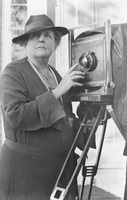 | Back to e-WV
| Back to e-WV
 The West Virginia Encyclopedia
The West Virginia Encyclopedia
 | Back to e-WV
| Back to e-WV
 The West Virginia Encyclopedia
The West Virginia Encyclopedia

Photographer Frances Benjamin Johnston (January 15, 1864-March 16, 1952) was born in Grafton but spent much of her youth in Rochester, New York, and in Washington. She began studying art at Notre Dame Convent in Govanston, Maryland, as an adolescent. From 1883 to 1885, she studied at the Académie Julian in Paris. She later continued her education at the Art Students League in New York. In 1888, a family friend, George Eastman, gave Johnston an early model of his new roll-film camera.
Johnston began her professional life as an artist-reporter. Sensing a changing trend in journalistic illustration while working as the Washington correspondent for a New York newspaper, she turned fulltime to photography, studying under Thomas William Smillie, then head of the Division of Photography at the Smithsonian Institution. In 1894, she opened a Washington portrait studio; Johnston is believed to be the only woman operating a portrait studio at the time.
When advances in technology made photography viable for reproduction in newspapers and magazines, Johnston’s photographs of women workers in New England shoe factories were distributed over an early wire service, and she achieved national renown as the first female press photographer. She went on to enjoy a long and remarkable career as one of the leading documentary, portrait, and artistic photographers in the nation. In 1899, she made photographs at the Hampton Normal and Agricultural Institute in Virginia (now Hampton University). In 1902, at the request of Hampton alumnus Booker T. Washington, she did a similar group of photographs at the Tuskegee Institute in Alabama (now Tuskegee University).
She also photographed celebrities of the time, including Susan B. Anthony and Mark Twain, as well as five presidents: Grover Cleveland, Benjamin Harrison, William McKinley, Theodore Roosevelt and William Howard Taft. She photographed Admiral George Dewey and documented his crew aboard the flagship cruiser Olympia in 1899, thanks to a letter from Theodore Roosevelt. She received employment from the Benjamin Harrison and William Taft presidential administrations.
Among Johnston’s most significant achievements was a photographic survey of early American architecture of the South, conducted from 1933 to 1941 with the support of the Carnegie Corporation. Her work is represented in many museums, including the Museum of Modern Art in New York and the Baltimore Museum of Art. Johnston died in New Orleans. She was 88. More than 20,000 of her photographs, as well as 3,700 glass and film negatives, are housed at the Library of Congress.
Written by John A. Cuthbert
Daniel, Pete & Ray Smock. A Talent for Detail: The Photographs of Miss Frances Benjamin Johnston. New York: Harmony Books, 1974.
Woodward, Richard B.. "Overlooked No More: Frances B. Johnston, Photographer Who Defied Genteel Norms". New York Times, Dec. 15, 2021.